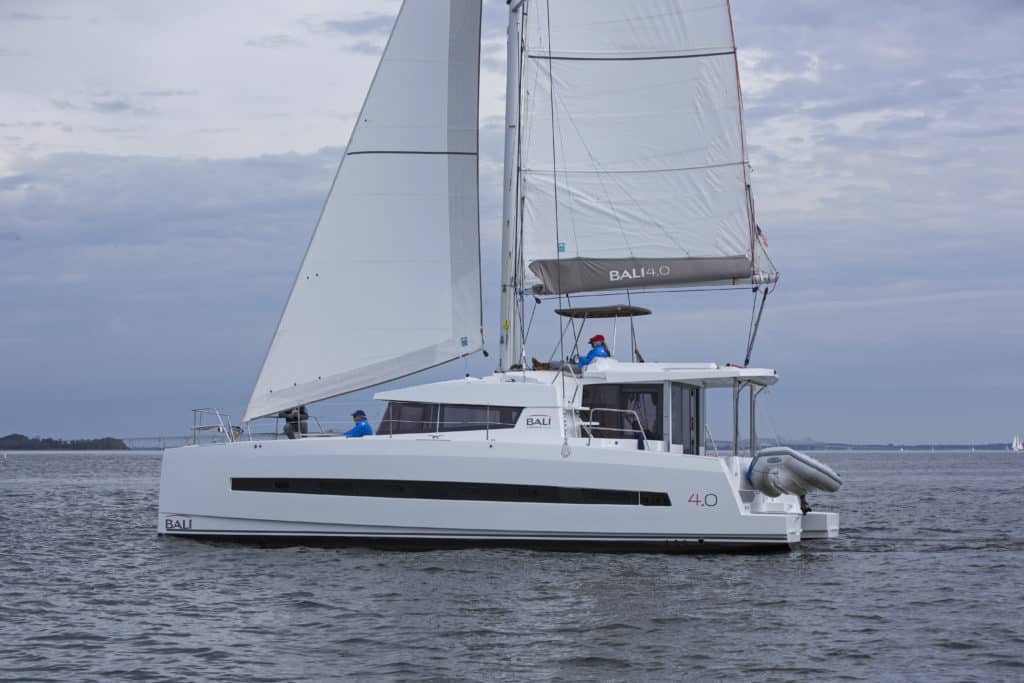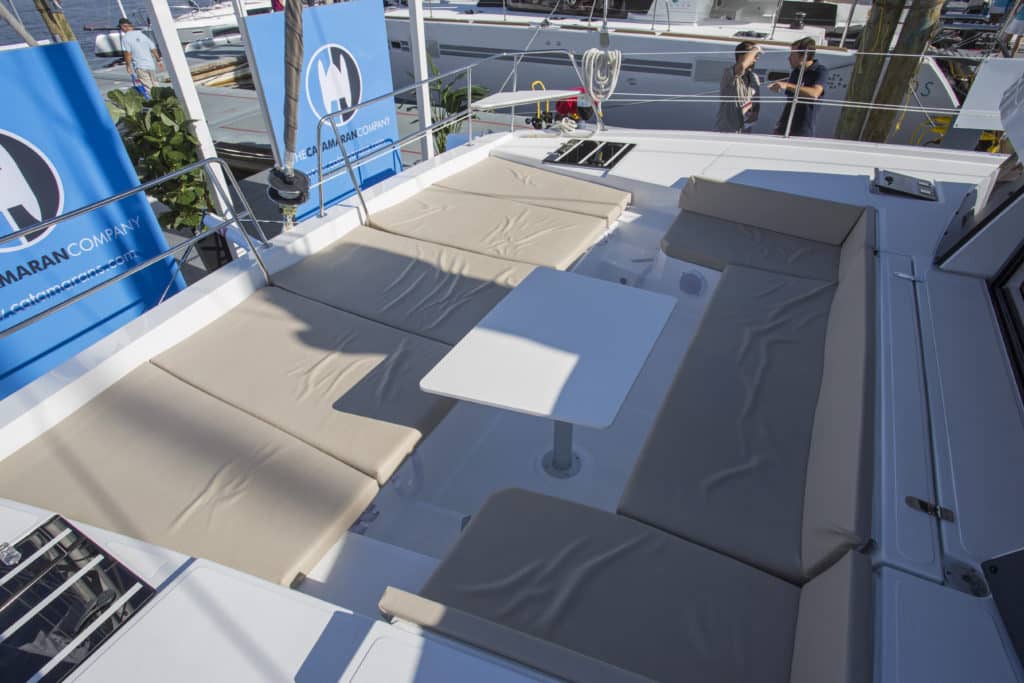
When the first big squall came through, we partially closed the saloon’s forward window but left everything else open. We kept the entire aft bulkhead raised, garage-door style, and locked in its up position. Even in heavy rain, a steady breeze through the open saloon — galley, nav station, dinette, two long settees and a swim platform — kept us all comfortable in the tropical heat. Though our chartered Bali 4.0 Lounge was fitted with air conditioning, in eight days of Caribbean sailing we never once felt the need to use it.
Since 1984, Catana catamarans have been built in the French Catalonia region, near the Mediterranean Sea and the border with Spain. For its first 30 years, the Catana brand staked out the performance end of the cruising-cat market: fast boats with fine hull sections and high-tech cored laminates, fitted with daggerboards for optimal windward performance. Many recent Catanas feature carbon rigs. Initially quite Spartan, Catana models evolved over the decades in the direction of carrying ever more luxury appointments; still, they clearly remained sophisticated sailors’ boats. The very details that made Catanas sail so well made them less ideal for bareboat charterers.
Olivier Poncin, Catana’s managing director, created the Bali range for the charter market and to the following specifications: “oversize and entirely open living spaces with a forward cockpit and sunbathing area, uniquely self-sufficient in power, and at competitive prices.” In the case of the new 40-footer, that comes to $450,000 sailaway (October 2016), delivered to the United States.
The Bali’s design clearly has drawn from trends started by other builders — flybridge helm for shorthanders, forward cockpit, open floor plan — then pushed this openness beyond the marks set by all previous competitors. Nearly unique among today’s cats, the Bali’s saloon occupies the entire bridgedeck, with no fixed bulkhead separating an interior saloon from an exterior cockpit. Instead, the entire aft bulkhead raises up and out of the way, or closes and locks into the down position with barrel bolts for open-water sailing, leaving a typical sliding door through which to enter and exit. A single line to a stopper near the flybridge helm raises and lowers a combination swim platform and dinghy davits.

A unique feature of the Bali occurs forward of the cabin. The composite bridgedeck structure extends all the way forward to the bows, with no nets between the hulls. The entire forward end of the boat between the hulls is dedicated to a dinette with wraparound settees and a sun pad built for two. This represents a design trade-off: exemplary socializing space on deck in exchange for the performance that’s lost when a builder adds weight in the ends of the boat. This is consistent with other design choices, such as fixed low-aspect keels and a modest sail plan with a small mainsail that together render the boat more simple to sail than likely to win races.
On the boat we sailed, this forward cockpit introduced a couple of challenges around the anchor, which exits the hull several feet aft from the bow. The first challenge was to connect an anchor bridle; doing so required a second person to get off the boat and into a dinghy, as there was no other way to reach the anchor roller and chain from the deck. The second challenge came when we sailed into the wind and waves. Seawater entering through the anchor roller soaked the boat’s propane tank, genset and genset starter battery in a forward compartment, all of which showed signs of corrosion.
Like many of the newer flybridge designs, the Bali is set up for shorthanded sailing. We found that raising and lowering sails worked best with two people: one stands on the side deck to control halyards and tails coming from the single power winch while the other one drives. Sun pads and seats on the flybridge provided ample room for our full crew of five, with room still available for more. Stepping down off the flybridge and into the aft cabin entrance while underway, we wished for better handholds on both port and starboard side decks.
The accommodations down in the hulls are spacious. Our three-cabin layout featured two double cabins, each with its own private en suite head and shower to starboard, and to port a full owners suite, with an office area, massive head and separate shower stall.
True to its design brief, it’s as a charter platform, with its exemplary open spaces, that the Bali truly shines.
– – –
Tim Murphy is a Cruising World editor at large and an independent book editor based in Rhode Island.








